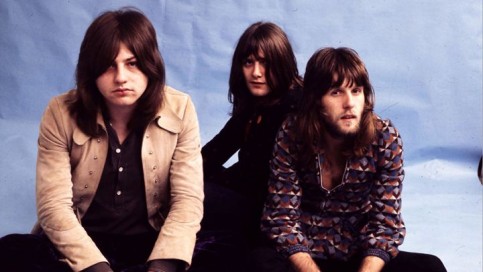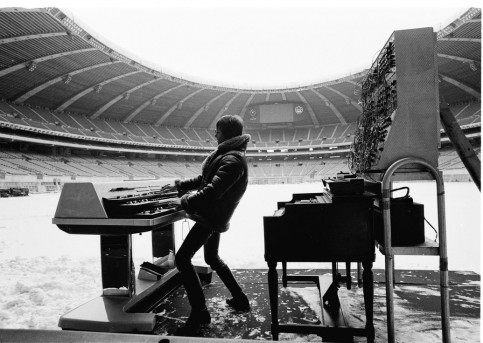“I was scared shitless,” the late Keith Emerson told Mojo in 2001, remembering the start of Emerson, Lake & Palmer’s 1977 tour of America — at the time, the most extravagant rock tour ever assembled. The setup legendarily included drummer Carl Palmer’s karate instructor, an army of roadies and, least practical of all, a full orchestra. Despite the cost and difficulty, “we had to be honest with our fans,” Emerson said. “My piano concerto on our double album, Works, which accompanied the tour, was augmented by an orchestra, and what you hear on the record is what you expect to hear when you buy the ticket to the show!”

That is the majesty of ELP. Veterans of a variety of Sixties British rock bands — Emerson played in the Nice, Palmer hailed from Atomic Rooster and Greg Lake migrated from King Crimson — ELP became one of rock’s first supergroups upon forming in 1970. In fact, ELP practically defined the term. Before punk came along and took progressive rock down a peg, the trio enjoyed the kind of success that could have only happened in the Seventies, when musicians strained at the confines of two-minute singles and dance-ready beats.
The result was a stretch of albums — as well as a smattering of fluke radio hits like 1970’s melancholy “Lucky Man” — that turned prog from a black-light-in-the-basement listening experience into a stadium-filling phenomenon. At their heart was Emerson, whose eternal quest for a bigger, grander sound (thanks to a bank of organs and synthesizers that grew to resemble a fortress onstage) helped make ELP one of the most accomplished and absorbing bands rock ever birthed. Here are a few of their shining moments.
“Lucky Man” (1970)
Dredged up from memory by Greg Lake, who wrote it at age 12 upon receiving his first guitar, “Lucky Man” is a “simplistic little medieval fantasy” (according to its composer) intended to fill out the trio’s first album. It turned out to be the Moog synthesizer’s pop breakthrough thanks to Keith Emerson’s memorable first-take solo – on a newly delivered instrument – as it ended. Emerson would have preferred a second pass, but no tracks were left to record on, so “that’s the solo I’ve had to live with!” The tune accrued its own mythology when listeners began associating its lyrics with public figures like President John F. Kennedy. R.G.
Like most prog ensembles of the era, ELP was never much of a singles band. Apart from early hit “Lucky Man,” “The Barbarian,” was the true introduction to the public at large of ELP’s staggering scope. In a mere four and a half minutes, the song segues from proto-metal heaviness to jaunty jazziness to a frenetic, piano-driven passage by Emerson that feels like an homage to Khachaturian’s “Sabre Dance.” Speaking to Sounds in 1970, Emerson remarked, “On the new album, the first side is Emerson, Lake and Palmer as a group – three ideas which have grown from three separate backgrounds to produce a sound … The nice thing about ELP is that we all bend to each other.” J.H.
“Tarkus” (1971)
No one ever accused ELP of being modest, and nowhere is that more evident than on “Tarkus.” Side A of the group’s sophomore album is broken down into seven movements – totaling more than 20 minutes of music –that fold fusion and classical elements into a mythic prog sprawl revolving around a fantastic creature. Emerson himself had the spark of inspiration. “With Tarkus I went through all sorts of Greek mythology books to think of a name for this animal,” he said in a 1972 interview with Disc, “and I didn’t come up with anything. Then suddenly we were driving home from a gig one night, and I said ‘Tarkus.’ And the others said, ‘Tarkus?’ And that was it.” The entire lifecycle of the being – depicted on the album cover’s iconic artwork by William Neal – is detailed in the song, which features some of Emerson’s most lush and dexterous keyboard work. J.H.
“From the Beginning” (1972)
Although it’s undeniably a showcase for Greg Lake’s moody acoustic guitar and vocals, “From the Beginning” from ELP’s Trilogy provided the space for one of Emerson’s most noteworthy keyboard solos. The final minute of the otherwise sparse, simple song are launched into another dimension by Emerson’s cosmic synthesizer jam. It’s a swirling, pinging symphony of outer space static – complete with overdubbed effects randomly generated by his synth – that expands the song’s scale from love-song intimacy to something that might have to do with the Big Bang. The band’s highest-charting single in the States, it also helped draw attention to Emerson’s beloved arsenal of Moogs, the synthesizers that ELP helped make legendary. J.H.
“Hoedown” (1972)
A showstopper that was actually a show starter for two tours, “Hoedown” was the first ELP adaptation of composer Aaron Copland, as brassy a show-off (in his way) as the trio itself. Keith Emerson began work on the piece after returning from a classical festival in Romania, so East European elements find their way into his rollicking organ and Moog arrangement alongside American folk tunes like “Shortnin’ Bread” and “Turkey in the Straw.” Emerson stumbled onto the track’s signature synth sound by chance: “We’d started working on that arrangement and then I hit, I don’t know what, I switched a blue button and I put a patch cord in there, but anyway, ‘whoooeee.'”
Emerson’s lilting, melodic piano opens “Trilogy,” the longest and most ambitious track from ELP’s third album. Co-written by Emerson and Greg Lake, it starts out with uncharacteristic restraint: The song is almost a conventional, straightforward, even Zombies-esque love ballad – that is, until the monstrous riffs and baroque synth workouts that hold layers upon layers of intricacy. As Emerson told Disc magazine the year of the song’s release, “I try to cover all sorts of things in my music so there are lots of things to be discovered in it maybe a little later. That’s one of the important points in music, the discovery by the listener of new things every time they hear a piece of music.”
Keith Emerson’s brash and playful arrangement of the 4th Movement of Alberto Ginastera’s Concerto for Piano No. 1 combined ELP’s passion for classical music with their fascination with state-of-the-art musical technology — the track may have been the first commercial recording to feature pre-programmed electronic percussion. The band initially met with resistance from Ginastera’s publishers when they asked for permission to include “Toccata” on 1973’s Brain Salad Surgery, so Emerson flew to the composer’s home in Switzerland to plead his case in person. “I had a nice lunch with Alberto and his wife and then I played the tape for him,” Emerson recalled in 2014. “When it was over he had this strange look on his face. He looked like he was in pain! And he said something like, I can’t remember the exact words but something like, ‘That is horrible!’ I thought, Oh God, he hates it! And I was ready to go home. But his wife said to us: ‘No, no, no, he says ‘diabolical’ in a good way, like ‘unbelievable!'” Ginastera’s personal endorsement of the track — “Keith Emerson has beautifully caught the mood of my piece” — would be included in Brain Salad Surgery‘s liner notes. D.E.
“Still… You Turn Me On” (1973)
“Rock technology is just not yet advanced enough,” Emerson lamented in a New York Times interview in 1973. Like the rest of the band, he was always groping for the next innovation that might fuel ELP’s evolution — although on “Still… You Turn Me On” from the group’s fourth album, Brain Salad Surgery, the notoriously tech-driven outfit pared things down. Relatively speaking, anyway; the Lake-penned tune doesn’t go in for many frills, relying instead on a luscious melody and Emerson’s tasteful synth flourishes — not to mention a startling dose of a different kind of innovation, at least for ELP: funk. Mostly it’s the balance between Lake’s songcraft and Emerson’s atmosphere that makes “Still… You Turn Me On” so timeless. Even when obsessed with the sounds of the future, ELP knew a good tune was always at the heart of their art. J.H.
Karn Evil 9″ (1973)
One of the most iconic progressive rock epics ever recorded, “Karn Evil 9” embodied everything that prog was both loved and reviled for. A staggeringly complex and ambitious work in three “impressions,” the centerpiece of 1973’s Brain Salad Surgery explored the weighty theme of man versus technology, while also giving the band members ample space in which to showcase their instrumental virtuosity. Though truly “the show that never ends” to the band’s detractors, the half-hour-long dystopian fantasy sounds prescient today. “It was the start of computer technology, and already we were being accused of using computer technology in our instrumentation to the point that some people actually believed that when we played onstage it wasn’t us!” Keith Emerson recalled in 2000. “When we did it live I had the Moog turn around, face the audience and blow up while we left the stage. It was like saying, ‘This is computer technology and it’s taking over.'” D.E.
“Fanfare for the Common Man” (1977)
The first track on the collaborative side of ELP’s solo-centric double album Works Volume 1, “Fanfare for the Common Man” was adapted from a 1942 composition by Aaron Copland, whom Keith Emerson regarded as “the soul of American music.” Emerson transposed Copland’s score to the key of E, and the band recorded the track as an inspired first take that sandwiches a nasty blues shuffle between straight-forward renditions of Copland’s theme, which led the composer to observe, “What they do in the middle, I’m not sure exactly how they connect that with my music but [laughs] they do it someway, I suppose.” Released with the composer’s blessing, the trio’s 10-minute adaptation would become a ubiquitous fist pumper during many televised sports events. R.G.
Emerson, Lake and Palmer, Music



You must be logged in to post a comment Login